Themed collection Spotlight Collection: Lanthanide and transition metal complexes as molecular magnets

Lanthanide and transition metal complexes as molecular magnets
Guest editor Vadapalli Chandrasekhar introduces the spotlight collection “Lanthanide and transition metal complexes as molecular magnets”.

Dalton Trans., 2022,51, 4199-4201
https://doi.org/10.1039/D2DT90035A
Designed polynuclear lanthanide complexes for quantum information processing
The design of dissymmetric organic ligands has been exploited to produce heterometallic dinuclear and trinuclear lanthanide-based coordination compounds with the requirements to act as logical quantum gates for spin-based quantum computing.
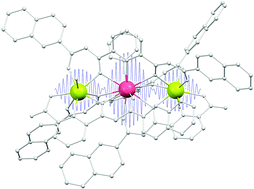
Dalton Trans., 2021,50, 12045-12057
https://doi.org/10.1039/D1DT01862K
Conducting single-molecule magnet materials
Multifunctional molecular materials exhibiting electrical conductivity and single-molecule magnet (SMM) behaviour are particularly attractive for electronic devices and related applications owing to the interaction between electronic conduction and magnetization of unimolecular units.
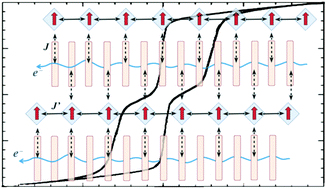
Dalton Trans., 2018,47, 7616-7627
https://doi.org/10.1039/C8DT01015C
Six-coordinated dinuclear lanthanide(III) amide complexes: investigation of magnetization relaxation dynamics and their electronic structures
A series of rare six-coordinated dinuclear Ln(III) complexes were characterized using a bulky amide ligand. Dy(III) analogue shows slow relaxation of magnetization in the absence of an external magnetic field. This has been rationalized by ab initio calculations.
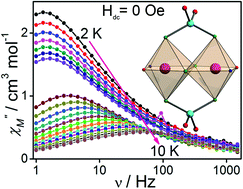
Dalton Trans., 2022,51, 63-68
https://doi.org/10.1039/D1DT03708K
Assessment of minimal active space CASSCF-SO methods for calculation of atomic Slater–Condon and spin–orbit coupling parameters in d- and f-block ions
CASSCF-SO calculations in OpenMolcas are used to determine Slater-Condon and SOC parameters for 3dn, 4dn, 5dn and 4fn ions. We quantify the error of minimal active space approaches and compare to other similar methods.

Dalton Trans., 2021,50, 14130-14138
https://doi.org/10.1039/D1DT02346B
Slow magnetic relaxation influenced by change of symmetry from ideal Ci to D3d in cobalt(II)-based single-ion magnets
Two mononuclear complexes including the same cation [Co(imidazole)6]2+ and the different symmetries Ci and D3d showed discriminatively slow magnetic relaxation.
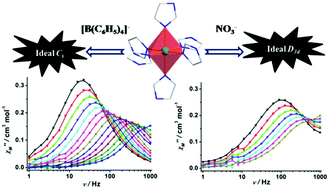
Dalton Trans., 2018,47, 2506-2510
https://doi.org/10.1039/C7DT04651K
Macrocycle based dinuclear dysprosium(III) single molecule magnets with local D5h coordination geometry
Bis(pyrazolato)-bridged macrocycles are shown to serve as scaffolds for Dy2 single molecule magnets with control over the relative orientation of anisotropy axes.

Dalton Trans., 2021,50, 17573-17582
https://doi.org/10.1039/D1DT02815D
Tunable magnetic anisotropy in luminescent cyanido-bridged {Dy2Pt3} molecules incorporating heteroligand PtIV linkers
The halogeno-cyanido PtIV complex was used as a metalloligand in emissive {DyIII2PtIV3} single-molecule magnets tuned by the solvent-dependent coordination geometry and alignment of Me3PO ligands.
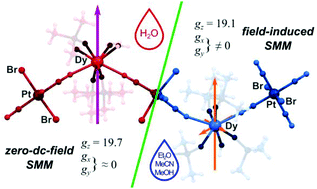
Dalton Trans., 2021,50, 16242-16253
https://doi.org/10.1039/D1DT03071J
Field-induced single ion magnet behaviour of discrete and one-dimensional complexes containing [bis(1-methylimidazol-2-yl)ketone]-cobalt(II) building units
Three {CoII(Rbik)2} single-ion magnets (SIMs) based on the Mebik ligand [Mebik = bis(1-methylimidazol-2-yl)ketone] and one mixed-valence {CoIII2CoII}n chain of CoII SIMs connected by diamagnetic {CoIII2(μ-2,5-dpp)(CN)8} spacers are discussed.
![Graphical abstract: Field-induced single ion magnet behaviour of discrete and one-dimensional complexes containing [bis(1-methylimidazol-2-yl)ketone]-cobalt(ii) building units](/en/Image/Get?imageInfo.ImageType=GA&imageInfo.ImageIdentifier.ManuscriptID=D1DT02441H&imageInfo.ImageIdentifier.Year=2021)
Dalton Trans., 2021,50, 16353-16363
https://doi.org/10.1039/D1DT02441H
Are lanthanide-transition metal direct bonds a route to achieving new generation {3d–4f} SMMs?
3d–4f metal–metal bonds are utilised to enhance exchange coupling to the order of several hundred wavenumbers.
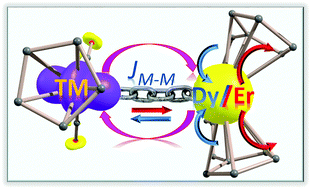
Dalton Trans., 2021,50, 16099-16109
https://doi.org/10.1039/D1DT02256C
Single-molecule magnets within polyoxometalate-based frameworks
Two polyoxometalate-based frameworks containing holmium and terbium are synthesized. Their single-molecule magnet (SMM) properties are investigated, where weak field-induced SMM behaviour is observed at low temperatures in dynamic magnetic studies.
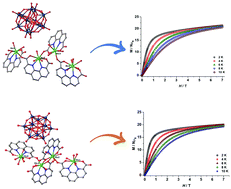
Dalton Trans., 2021,50, 15047-15056
https://doi.org/10.1039/D1DT01708J
A rare isostructural series of 3d–4f cyanido-bridged heterometallic squares obtained by assembling [FeIII{HB(pz)3}(CN)3]− and LnIII ions: synthesis, X-ray structure and cryomagnetic study
A rare isostructural series of cyanido-bridged {FeIIILnIII}2 square-shaped heterobimetallic complexes were obtained, in which TbIII, DyIII and ErIII derivatives show slow magnetization relaxation under zero and non-zero static fields.
![Graphical abstract: A rare isostructural series of 3d–4f cyanido-bridged heterometallic squares obtained by assembling [FeIII{HB(pz)3}(CN)3]− and LnIII ions: synthesis, X-ray structure and cryomagnetic study](/en/Image/Get?imageInfo.ImageType=GA&imageInfo.ImageIdentifier.ManuscriptID=D1DT02512K&imageInfo.ImageIdentifier.Year=2021)
Dalton Trans., 2021,50, 14640-14652
https://doi.org/10.1039/D1DT02512K
3d–4f magnetic exchange interactions and anisotropy in a series of heterobimetallic vanadium(IV)–lanthanide(III) Schiff base complexes
3d–4f complexes were prepared and their X-ray analyses revealed changes in the coordination number upon changing the lanthanide (Gd → Er). The VIV–LnIII magnetic exchange was fit from magnetic data and calculated by DFT and CASSCF theoretical models.
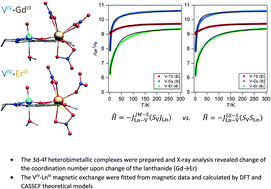
Dalton Trans., 2021,50, 13883-13893
https://doi.org/10.1039/D1DT01944A
Auxiliary alkyl chain modulated spin crossover behaviour of [Fe(H2Bpz2)2(Cn-bipy)] complexes
The length of the alkyl chain substituents employed in complexes [Fe(H2Bpz2)2(Cn-bipy)] can have a large impact on the transition temperature and solid state spin crossover profile.
![Graphical abstract: Auxiliary alkyl chain modulated spin crossover behaviour of [Fe(H2Bpz2)2(Cn-bipy)] complexes](/en/Image/Get?imageInfo.ImageType=GA&imageInfo.ImageIdentifier.ManuscriptID=D1DT01787J&imageInfo.ImageIdentifier.Year=2021)
Dalton Trans., 2021,50, 12835-12842
https://doi.org/10.1039/D1DT01787J
Enhancing the barrier height for magnetization reversal in 4d/4f RuIII2LnIII2 “butterfly” single molecule magnets (Ln = Gd, Dy) via targeted structural alterations
Single molecule magnetic features of new {RuIII2DyIII2} “butterfly” clusters are compared, by experiment and theory, to those of 3d/4f analogues.
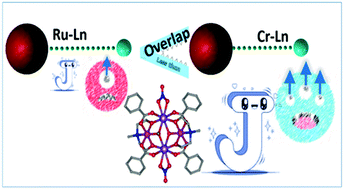
Dalton Trans., 2021,50, 12265-12274
https://doi.org/10.1039/D1DT01770E
Two types of Ln2Cu2 hydroxo-trimethylacetate complexes with 0D and 1D motifs: synthetic features, structural differences, and slow magnetic relaxation
The insertion of Na+ ions into the structure of LnIII2CuII2 hydroxo-trimethylacetate complexes leads to a change in the butterfly-like metal core geometry giving rise to a significant change in their slow magnetic relaxation.

Dalton Trans., 2021,50, 12275-12286
https://doi.org/10.1039/D1DT01161H
Study of the influence of nuclear spin and dilution over the slow relaxation in a 3d4f heterobimetallic single-molecule magnet
Isotopic enrichment and magnetic dilution influenced the magnetic performance of a 3d4f heterobimetallic single-molecule magnet in both zero and applied magnetic field.

Dalton Trans., 2021,50, 11466-11471
https://doi.org/10.1039/D1DT01608C
Magnetic anisotropy on demand exploiting high-pressure as remote control: an ab initio proof of concept
An in silico proof of concept showed that detectable changes in magnetic anisotropies can be achieved by applying pressure on molecular magnetic systems containing lanthanides.
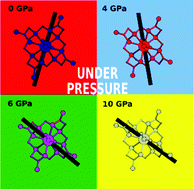
Dalton Trans., 2021,50, 10621-10628
https://doi.org/10.1039/D1DT01719E
Structural, magnetic and theoretical analyses of anionic and cationic phthalocyaninato-terbium(III) double-decker complexes: magnetic relaxation via higher ligand-field sublevels enhanced by oxidation
Ligand oxidation of single-molecule magnets enhances magnetic relaxations via higher energy levels.
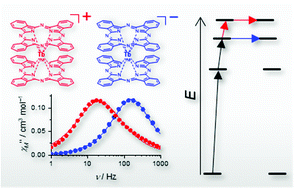
Dalton Trans., 2021,50, 9719-9724
https://doi.org/10.1039/D1DT00775K
Tetrairon(II) extended metal atom chains as single-molecule magnets
The iron(II)-based extended metal atom chains [Fe4(tpda)3X2] (X = Cl, Br) have a weakly magnetic ground state but display SMM properties, which are detectable even in zero DC field when X = Br.

Dalton Trans., 2021,50, 7571-7589
https://doi.org/10.1039/D1DT01007G
A new class of DyIII-SIMs associated with a guanidine-based ligand
The diverse relaxation dynamics of a series of DyIII-based SIMs resulting from the coordinated molecules and counter anions were elucidated by structural analysis, magnetic investigations and ab initio calculations.
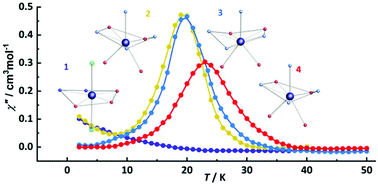
Dalton Trans., 2021,50, 5146-5153
https://doi.org/10.1039/D1DT00260K
A trapped hexaaqua CoII complex between the polyanionic sheets of decavanadate reveals high axial anisotropy and field induced SIM behaviour
A hexaaqua CoII complex within the anionic metal oxide cluster of decavanadates reveals easy-axis anisotropy and field induced SIM behaviour with a high energy barrier for the spin reversal process.
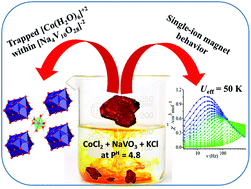
Dalton Trans., 2021,50, 3825-3831
https://doi.org/10.1039/D0DT04339G
Slow magnetic relaxation in penta-coordinate cobalt(II) field-induced single-ion magnets (SIMs) with easy-axis magnetic anisotropy
Two penta-coordinate [Co(Ln)(NCS)]ClO4 with substituted pyridyl based bispyrazolyl ligands have been structurally characterized. The complexes show an easy-axis magnetic anisotropy, large rhombicity and slow relaxation of magnetization.
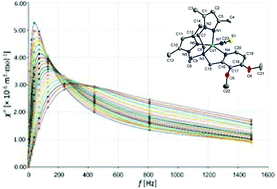
Dalton Trans., 2020,49, 11715-11726
https://doi.org/10.1039/D0DT02338H
Radii-dependent self-assembly of chiral lanthanide complexes: synthesis, chirality, and single-molecule magnet behavior
Here we report the radii-dependent self-assembly of chiral lanthanide complexes and the single-molecule magnet behavior of the Dy5 complexes.
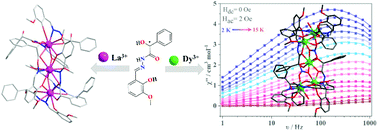
Dalton Trans., 2020,49, 10120-10126
https://doi.org/10.1039/D0DT01711F
Structure and magnetic properties of a novel heteroheptanuclear metal string complex [Ni3Ru2Ni2(μ7-teptra)4(NCS)2](PF6)
A novel heteroheptanuclear metal string complex was synthesized by using nickel and ruthenium metal ions to explore the electronic structure and magnetic property.
](/en/Image/Get?imageInfo.ImageType=GA&imageInfo.ImageIdentifier.ManuscriptID=D0DT00156B&imageInfo.ImageIdentifier.Year=2020)
Dalton Trans., 2020,49, 6635-6643
https://doi.org/10.1039/D0DT00156B
The slow magnetic relaxation regulated by the coordination, configuration and intermolecular dipolar field in two mononuclear DyIII single-molecule magnets (SMMs)
Tuning the magnetic dynamics of single-molecule magnets (SMMs) is a crucial challenge for chemists.
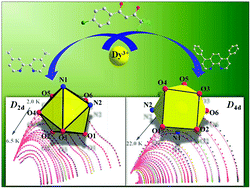
Dalton Trans., 2018,47, 12393-12405
https://doi.org/10.1039/C8DT02361A
A difunctional azido-cobalt(II) coordination polymer exhibiting slow magnetic relaxation behaviour and high-energy characteristics with good thermostability and insensitivity
As a difunctional material, an azido-Co(II) coordination polymer with a high-nitrogen content exhibits both molecule-based magnetic behaviour and high-energy performance with superior thermostability and insensitivity.
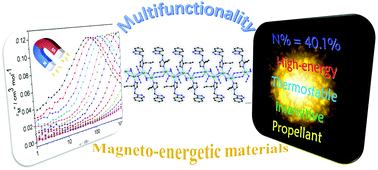
Dalton Trans., 2018,47, 12092-12104
https://doi.org/10.1039/C8DT02335B
3D LnIII-MOFs: slow magnetic relaxation and highly sensitive luminescence detection of Fe3+ and ketones
Five Ln-MOFs were obtained: the Dy-MOF shows slow magnetic relaxation, and the Eu-MOF and Tb-MOF show selective and sensitive sensing towards Fe3+ ions and ketones in a water system.

Dalton Trans., 2018,47, 8972-8982
https://doi.org/10.1039/C8DT01034J
Magnetic properties and structure of tetranuclear lanthanide complexes based on 8-hydroxylquinoline Schiff base derivative and β-diketone coligand
Herein, we report the synthesis, structure, and magnetism of five tetranuclear LnIII complexes encapsulated by 5-(4-pyridinecarboxaldehyde)amino-8-hydroxylquinoline and β-diketonate coligand.
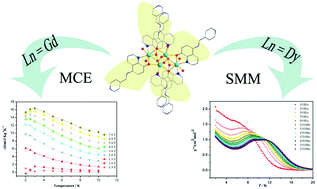
Dalton Trans., 2018,47, 3503-3511
https://doi.org/10.1039/C8DT00063H
About this collection
Welcome to a Spotlight themed collection published by Dalton Transactions.
The research area of molecule-based magnets encompassing single-molecule magnets (SMMs), single-ion magnets (SIMs) and single-chain magnets (SCMs) has been extremely active in recent years. This field is truly interdisciplinary and the advances in this field have been possible only due to a concerted effort from synthetic coordination- and organometallic chemists, physicists, materials scientists, and theoreticians. Research in this field is driven by both academic curiosity as well as the possibility of finding exotic applications such as high-density information to quantum computation. While many challenges remain to be overcome before the potential of these new materials can be realized, there has been substantial progress both in the design and assembly of these new systems as well as in understanding of their properties. This appears to be an appropriate time to bring out a special edition of Dalton Transactions on this multi-disciplinary subject.
This collection is guest edited by Dalton Transactions Associate Editor Vadapalli Chandrasekhar (Indian Institute of Technology Kanpur).
Articles will be added to this themed collection as soon as possible after they are published. Please return to this page frequently to see the collection grow.
If you would like to contribute an article to this collection, please contact the Editorial Office at dalton-rsc@rsc.org with your proposed topic.